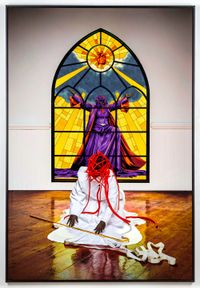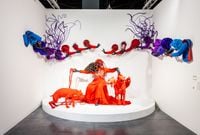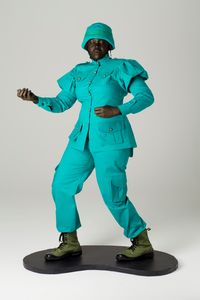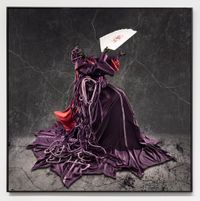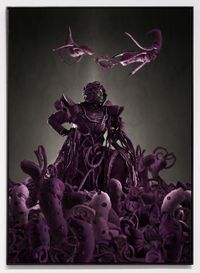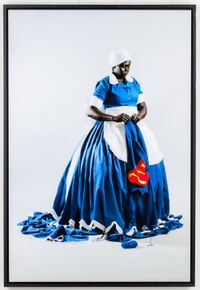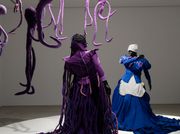Mary Sibande (b. 1982, South Africa) is a sculptor, painter and installation artist whose work not only engages as an interrogator of the current intersections of race, gender and labour in South Africa; but continues to actively rewrite her own family's legacy of forced domestic work imposed by the then Apartheid State.
Read MoreSibande employs the human form as a vehicle through photography and sculpture as a focused critique on the stereotypical depictions of women, particularly black women in South Africa. The body, for Sibande, and particularly how we clothe it, is the site where this history is contested and where Sibande's own fantasies can play out. This counter history takes the form of an alter-ego in Sibande's early work, a persona by the name of 'Sophie' who is dressed in various uniforms that resemble the dresses worn by domestic workers. Altering these dress styles into Victorian motifs, Sibande completely reanimates Sophie's history through how her body is adorned and the way she occupies these narratives that were stolen and denied from her. This is not just a political act, but one of transformation, as Sophie takes on new incarnations of herself unbound from the laboured history of servitude; as it relates to the present in terms of domestic relationships. Transitioning from blue to purple to red, Sibande introduces us not only to the many faces of herself and 'Sophie', but to the complex person hoods of African Women who continue to create worlds and narratives outside of the canon of Western Imperialism.
In her newest work, we witness 'Sophie' as the High Priestess becoming the space between two realms; between the past and future, between what has been and what could be – she is fleeting, a personification of mystery and spirit which is unknown to the rational world. In this work, Sibande offers insight into the past, present and future, interpreting biblical and philosophical texts on wisdom into personal visions and prophecy. The Priestess represents magic and possibility through ancient cultural practices associated with sorcery whose traditions continue into the present day.
Most importantly, she attempts to exploit supernatural forces by summoning the spiritual and medicinal role inherent to magic and its associated rituals, gestures and languages. Sibande's works are included in the collections of the Toledo Museum of Art, Smithsonian National Museum of African Art, Virginia Museum of Fine Art; Museum of Contemporary Photography, Chicago, and many others.
Text courtesy Kavi Gupta.
